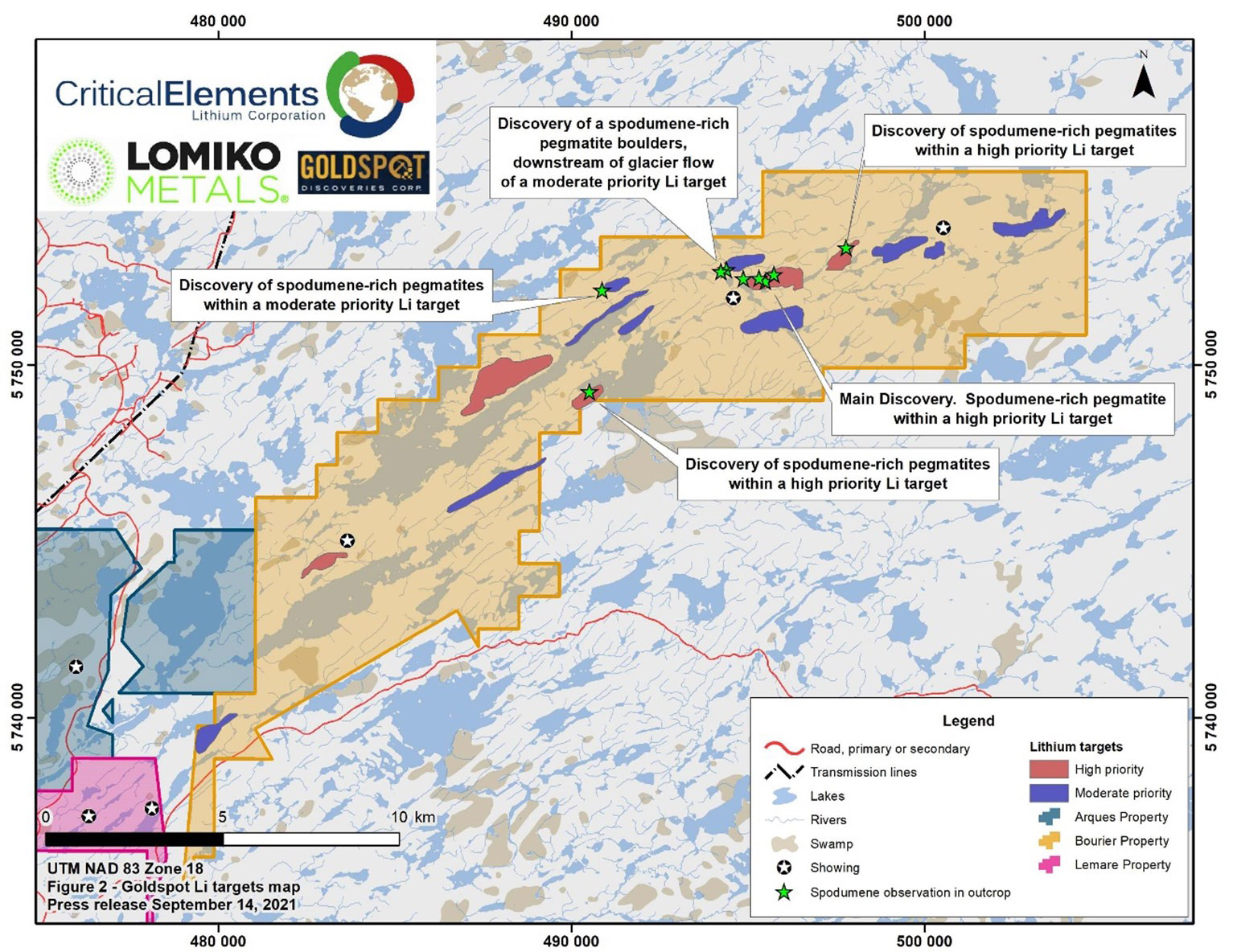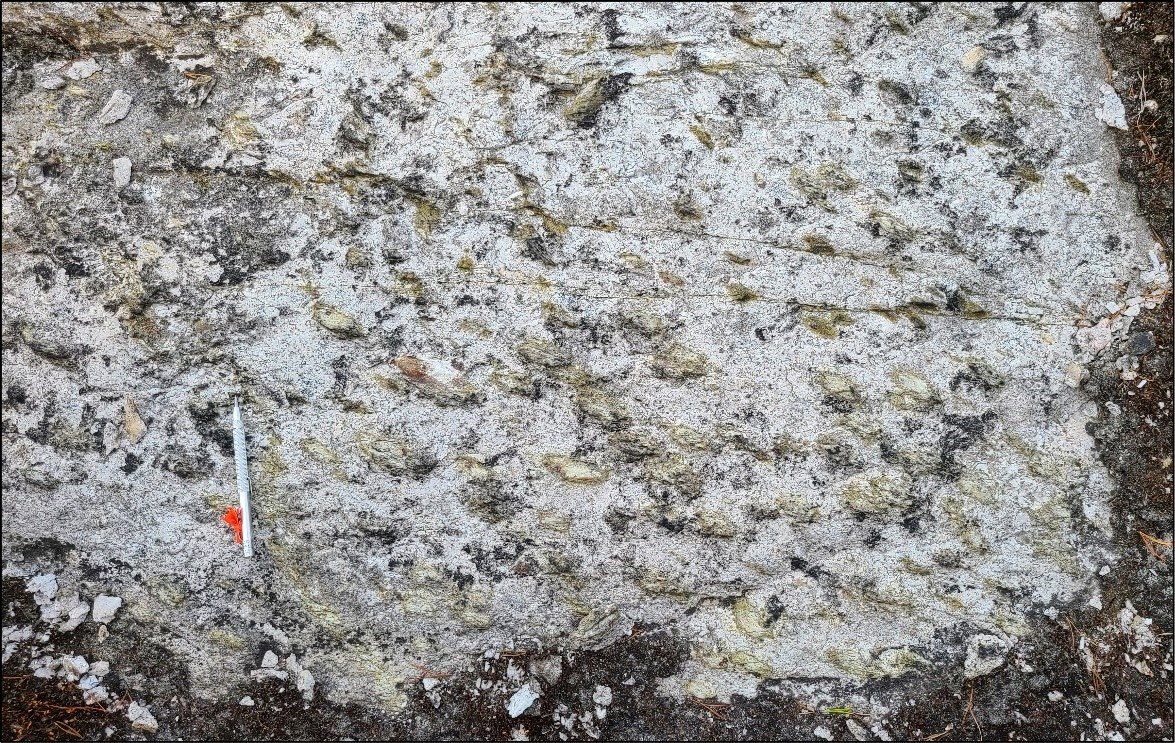MONTREAL–(September 14, 2021) Lomiko Metals Inc. (Lomiko) ((TSX-V: LMR, OTC: LMRMF, FSE: DH8C)) (“Lomiko Metals Inc or “Lomiko” or the “Corporation”) and Critical Elements Lithium Corporation (the “Company” or “Critical Elements”) (TSX-V: CRE) (US OTCQX: CRECF) (FSE: F12) mandated GoldSpot Discoveries Corp. (TSX-V: SPOT) (OTCQX: SPOFF) (“GoldSpot“) to conduct a remote targeting process for lithium, on the Bourier claims within the Nemiscau belt (Figure 1). GoldSpot uses cutting edge technology and geoscientific expertise to mitigate exploration risks and make mineral discoveries. To review the option agreement please see news April 27, 2021
Jean-Sébastien Lavallée, Chief Executive Officer of the Critical Elements, noted, “We are confident that continued exploration, benefitting from the deployment of GoldSpot’s AI analysis and our joint geoscientific expertise, will continue to reveal the considerable potential of the Bourier property.”
A. Paul Gill, Lomiko Metals CEO stated: “The results indicate Bourier requires extensive attention. Combined with Lomiko’s La Loutre Project which has already reported a PEA on July 29, 2021, Lomiko has had the best summer of its history.”
Release Highlights
- GoldSpot Discoveries Corp.’s proprietary approach of Artificial Intelligence (AI) and geological interpretation highlight lithium potential at Bourier claims within the Nemiscau greenstone belt;
- A total of 15 high to moderate prospectivity lithium targets were identified.
- Preliminary Summer 2021 field exploration results have revealed the discovery of five new sectors of spodumene-rich (Li) pegmatites, highlighting the potential of the Bourier project.
- Critical Elements and Lomiko Metals (Joint Venture) boast a unique and favorable land position for lithium exploration within the Nemiscau Belt.
Methodology
The study hinged on digital extraction from an exhaustive collection of compiled data, including assessment files, government data and academic studies. This dataset provided outcrop/sample description, bedrock geology, geochemical analyses, and geophysical surveys. Original data was cleaned and combined to create a comprehensive data set for geological interpretation and machine learning processes.
Geological Interpretation
The compilation of discrete outcrop observations allowed a reliable update to existing geologic maps, resulting in a refined lithium exploration-oriented pegmatite map. A total of 99 pegmatite bodies were added to the current geological map, highlighting previously unknown potential for economic lithium mineralization.
An up-to-date structural interpretation was created based on a high-resolution aeromagnetic survey commissioned by Critical Elements. This survey revealed structurally complex patterns, including large-scale folds and major ENE-trending ductile fault zones.
Lithium Target Generation
GoldSpot generated lithium targets using a knowledge-based approach with Artificial Intelligence (AI) data-driven methods.
Process
The AI data analysis trains machine learning algorithms to predict the presence of lithium using all variables (features), both numeric and interpreted on a 10 x 10 m grid cell datacube. Once the model performs to a satisfactory level, results produced include:
1) a series of zones with relatively high probability of containing lithium;
2) a ranking of feature importance for each input feature.
Performance
The best prediction model for lithium at Bourier was obtained using the Extended Euclidean Algorithm for which performance metric was at 75% precision. The updated lithology and structural interpretation were the dominant contributors to the targeting model.
Field Work and Preliminary Results
In preparation of field work, GoldSpot provided a map of probable outcrop zones, resulting from the AI analysis on high-resolution satellite imagery. The machine learning-assisted outcrop detection allows for time- and cost-efficient field exploration.
An exploration crew composed of Critical Elements’ and GoldSpot’s geoscientists conducted a 20-day prospecting program at the Bourier project, with focus on the high to moderate lithium targets generated by GoldSpot. The highlights of this program include the discovery of five new sectors of spodumene-rich (Li) pegmatite (laboratory analysis results are pending; Figure 2). These discoveries were made within, or the extension, of GoldSpot’s targets.

Figure 1: Location of Critical Elements’ projects, Eeyou Istchee, James Bay, Québec. Critical Elements and Lomiko Metals’ Bourier project on the Northeastern part of the Nemiscau belt.
Discovery
The main discovery, located about 11 km NE of the Bourier Lake, consists of muscovite and garnet pegmatites showing 1-5% of centimetric-size spodumene crystals (Figure 3), over an outcropping area of 40 x 30 m. Additional spodumene-rich pegmatites were sporadically found within a 1 km trend from the main discovery, highlighting the potential for wider mineralization system. Four other spodumene-rich pegmatites zones were found elsewhere on the property.

Figure 2: Lithium targets and location of new spodumene-rich pegmatites within Critical Elements and Lomiko Metals’ Bourier claims.
Results
A total of 15 lithium exploration targets were identified (Figure 2), reducing the area of investigation to approximately 9.5% of the total claim holding. The newly interpreted pegmatite outcrops largely controlled the distribution of the lithium targets.

Qualified Person
All technical information, not pertaining to the PEA, in this news release has been reviewed and approved by Mike Petrina, P.Eng., who is a “qualified person” as defined by National Instrument 43-101 – Standards of Disclosure for Mineral Projects (“NI 43-101”).
About Lomiko Metals Inc.
Lomiko Metals holds a 100% interest in its La Loutre graphite development in southern Quebec. Located 180 kilometres northwest of Montreal, the property consists of one large, continuous block with 42 minerals claims totalling 2,509 hectares (25.1km2). Lomiko also has a joint venture option to earn 70% of the Bourier project from Critical Minerals consisting of 203 claims, for a total ground position of 10,252.20 hectares (102.52 km2) in Canada’s lithium triangle near the James Bay region of Quebec that has lithium deposits and mineralization trends.
About Critical Elements Lithium Corporation
Critical Elements Lithium Corporation aspires to become a large, responsible supplier of lithium to the flourishing electric vehicle and energy storage system industries. To this end, Critical Elements Lithium is advancing the wholly owned, high purity Rose lithium project in Quebec. Rose is the Company’s first lithium project to be advanced within a highly prospective land portfolio of over 700 square kilometers. In 2017, the Company completed a robust feasibility study on Rose Phase 1 for the production of high quality spodumene concentrate. The internal rate of return for the Project is estimated at 34.9% after tax, with a net present value estimated at C$726 million at an 8% discount rate. Capital cost parameters were confirmed in 2019 by Primero Group in the context of a Guaranteed Maximum Price under an Early Contractor Involvement agreement, as a prelude to an Engineering, Procurement and Construction process. Detailed engineering for Phase I is expected to conclude this year as the Company plans to deliver technical studies for Phase II; the conversion of spodumene concentrate to high quality lithium hydroxide. In the Company’s view, Quebec is strategically well-positioned for US and EU markets and boasts exceptional infrastructure including a low-cost, low-carbon power grid featuring 93% hydroelectricity. The project has received approval from the Federal Minister of Environment and Climate Change on the recommendation of the Joint Assessment Committee, comprised of representatives from the Impact Assessment Agency of Canada and the Cree Nation Government; we await similar approval under the Quebec environmental assessment process near-term. The Company also has a strong, formalized relationship with the Cree Nation.
About GoldSpot Discoveries Corp.
GoldSpot Discoveries Corp. (TSXV: SPOT) (OTCQX: SPOFF) is a technology services company in mineral exploration. GoldSpot is a leading team of expert scientists who merge geoscience and data science to deliver bespoke solutions that transform the mineral discovery process. In the race to make discoveries, GoldSpot produces Smart Targets and advanced geological modelling that saves times, reduces costs and provides accurate results.
For more information on Lomiko Metals, review the website at www.lomiko.com, contact A. Paul Gill at 604-729-5312 or email: info@lomiko.com.
On Behalf of the Board,
“A. Paul Gill”
Chief Executive Officer
Neither the TSX Venture Exchange nor its Regulation Services Provider (as that term is defined in the policies of the TSX Venture Exchange) accepts responsibility for the adequacy or accuracy of this news release. No stock exchange, securities commission or other regulatory authority has approved or disapproved the information contained herein.

